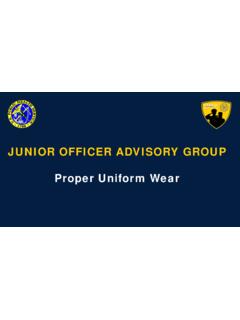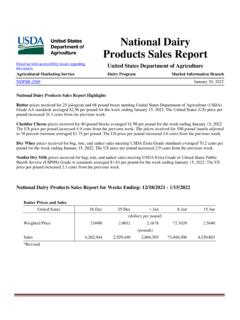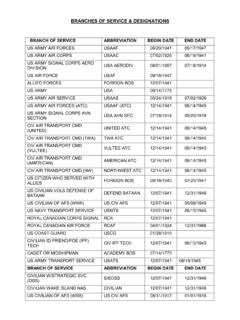Transcription of OSHA FACTSHEET BLOODBORNE PATHOGENS EXPOSURE …
1 Medical Evaluation and Follow-upWhen a worker experiences an EXPOSURE incident,the employer must make immediate confidentialmedical evaluation and follow-up available to theworker. This evaluation and follow-up must be:made available at no cost to the worker and at areasonable time and place; performed by or underthe supervision of a licensed physician or otherlicensed healthcare professional; and providedaccording to the recommendations of the health Service (USPHS) current at the timethe procedures take place. In addition, laboratorytests must be conducted by an accredited labora-tory and also must be at no cost to the worker. Aworker who participates in post- EXPOSURE evalua-tion and follow-up may consent to have his or herblood drawn for determination of a baseline infec-tion status, but has the option to withhold consentfor HIV testing at that time. In this instance, theemployer must ensure that the worker's bloodsample is preserved for at least 90 days in casethe worker changes his or her mind about HIVtesting.
2 Post- EXPOSURE prophylaxis for HIV, HBV, and HCV,when medically indicated, must be offered to theexposed worker according to the current recom-mendations of the public health Service. Thepost- EXPOSURE follow-up must include counselingthe worker about the possible implications of theexposure and his or her infection status, includingthe results and interpretation of all tests and howto protect personal contacts. The follow-up mustalso include evaluation of reported illnesses thatmay be related to the an EXPOSURE IncidentExposure incidents should be reported immedi-ately to the employer since they can lead to infec-tion with hepatitis B virus (HBV), hepatitis C virus(HCV), human immunodeficiency virus (HIV), orother BLOODBORNE PATHOGENS . When a workerreports an EXPOSURE incident right away, thereport permits the employer to arrange for imme-diate medical evaluation of the worker.
3 Earlyreporting is crucial for beginning immediate inter-vention to address possible infection of the work-er and can also help the worker avoid spreadingbloodborne infections to others. Furthermore, theemployer is required to perform a timely evalua-tion of the circumstances surrounding the expo-sure incident to find ways of preventing such asituation from occurring again. Reporting is also important because part of thefollow-up includes identifying the source individ-ual, unless the employer can establish that identi-fication is infeasible or prohibited by state or locallaw, and determining the source s HBV and HIVinfectivity status. If the status of the source indi-vidual is not already known, the employer isrequired to test the source s blood as soon as fea-sible, provided the source individual consents. Ifthe individual does not consent, the employermust establish that legally required consent can-not be obtained.
4 If state or local law allows testingwithout the source individual s consent, theemployer must test the individual s blood, if it isavailable. The results of these tests must be madeavailable to the exposed worker and the workermust be informed of the laws and regulationsabout disclosing the source s identity and infec-tious Pathogen EXPOSURE Incidents OSHA s BLOODBORNE PATHOGENS standard (29 CFR ) requires employers tomake immediate confidential medical evaluation and follow-up available for workerswho have an EXPOSURE incident, such as a needlestick. An EXPOSURE incident is a specific eye, mouth, other mucous membrane, non-intact skin, or parenteral contactwith blood or other potentially infectious materials (OPIM), as defined in the standardthat results from the performance of a worker s duties. This is one in a series of informational fact sheets highlighting OSHA programs, policies or standards.
5 It does not impose any new compliance requirements. For a comprehensive list of compliance requirements of OSHA standards or regulations, refer toTitle 29 of the Code of FederalRegulations. This information will be made available to sensory-impaired individuals upon voice phone is (202) 693-1999; teletypewriter (TTY) number: (877) OpinionThe employer must obtain and provide the worker with a copy of the evaluating healthcareprofessional s written opinion within 15 days ofcompletion of the evaluation. According toOSHA s standard, the written opinionshould only include: whether hepatitis B vaccination wasrecommended for the exposed worker; whetheror not the worker received the vaccination, andthat the healthcare provider informed the workerof the results of the evaluation and any medicalconditions resulting from EXPOSURE to blood orOPIM which require further evaluation or findings other than these are not to be includedin the written InformationFor more information, go to OSHA s BloodbornePathogens and Needlestick Prevention Safety andHealth Topics web page at: f i l e a c o m p l a i n t b y p h o n e , r e p o r t a n e m e r g e n c y,or get OSHA advice, assistance, or products, contact your nearest OSHA office under the of Labor listing in your phone book, or call us toll-free at (800) 321-OSHA (6742).
6 Occupational Safetyand health 1-800-321-6742 For assistance, contact can help. It s 1/2011















